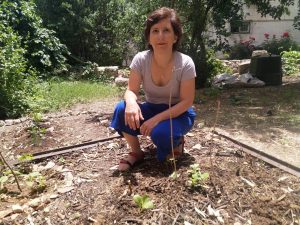
On the surface of it, it only took land, a compost bin, seedlings, work, and water. On the surface, this is what it took.
But really, honestly?
It took much more.
It took a few processes that were weaved together through time.
I traced a couple of the steps on the way. I will present them briefly showing how they interweave.
Step 1: Maya’s Potato Garden
Maya, our eldest daughter set forth to create a potato garden some four years ago in the yard of the apartment building we live in Jerusalem.
As the land of our Jerusalem yard was thick and hard she decided to add fresh soil on to the existing soil and plant the potatoes in this new layer of soil extending upwards from the ground.
For as long as she watered it, her potato garden grew. But with the heat of the summer coming in, fatigue came in too. Slowly and steadily the potato garden withered into non existence.
Step 2: Eden’s Composting Class at Szold School
When our youngest daughter Eden was in the fourth grade in Jerusalem’s Szold School three years ago, she had the privilege of having a teacher, Einat, who was very much into green education. Einat’s class was the school’s green class and was in charge of handling the school’s compost production.
At the beginning of the school year, parents were invited to bring fresh produce for a communal breakfast. The vegetable’ peels of that breakfast kickstarted the compost project at the school. I was part of that breakfast and still remember the ceremonial status the peels of the tomatoes, cucumbers, onions, peppers and parsley thinly chopped towards this Israeli salad enjoyed.
Students, teacher and parents alike all enjoyed the breakfast. Most importanly, the point of the event was transmitted to all: that peels have an afterlife when placed in the compost bin.
It is during that school year that our youngest daughter Eden pushed Elias, the father of the family, to finally assemble the compost bin that lay till that day in the darkness of our warehouse.
Step 3: Elias’ Assembling the Compost Bin
Following the tenants’ consent, Elias installed the compost bin in the yard. Through a what’s up announcement to the tenants’ group, Elias made the compost bin known and public by attaching its photo. Everyone, of course, was welcome to use it, but none other than us did till the corona crisis.
Step 4: Collecting Vegetable and Fruit Peels Daily
Almost every day one of us cooks at home.
We usually have a salad and some other vegetable-based dish, as is the custom in our Greek-Meditarranean-Israeli cuisine. By the evening, the plastic bin by our sink is filled up with vegetable and fruit peels. Each morning the pile is thrown into our compost bin at the yard. On top we put dry leaves and let it rest. It takes a few months of letting the pile run its processes, along with Elias meticulous care, before the compost is ready to nourish the earth.
Step 5: Adding the Compost in the Food Garden to Enrich the Soil
Now that I add the home-made compost to enrich the food-garden’s soil, I all of a sudden connect the dots.
I see the steps taken connecting between the seedlings that grow in the plot, the compost created from our daily peels, Elias’ compost care, Eden’s composting class and Maya’s potato garden.
The food garden could not have happened without them.
Connecting the Dots
On the surface of it, it only takes land, a compost bin, seedlings, work, and water to create a food garden somewhere.
But behind the scenes, it takes the weaving and interweaving of many processes, individual and communal, for you and me to be enjoying the life-force witnessed daily in our food gardens.
It takes the co-creation of many people. The visions, dreams, and work of many people and communities.
It takes the weaving of many processes, the weaving of many people’s hands-on-work and visions through the years.
Today I see it, and cherish it. And felt compelled to share it!
From Jerusalem with love,
Yvette Nahmia-Messinas
Lovely Yvette! So true- so many rich complexes remain unseen to our eyes. Just like the seeds that grow beneath the ground, it takes a while for us to witness all the processes that led up to that!
Thanks Tzippi for sharing your thoughts and feedback with me! I totally connect with the seeds that grow beneath the ground idea. It is in the realm of the unseen, to the unexercised eye. The more we practice our seeing, we see a wider image. Do you do the dream work still? The dreamwork was so much about toning the seeing muscle. Love, Yvette